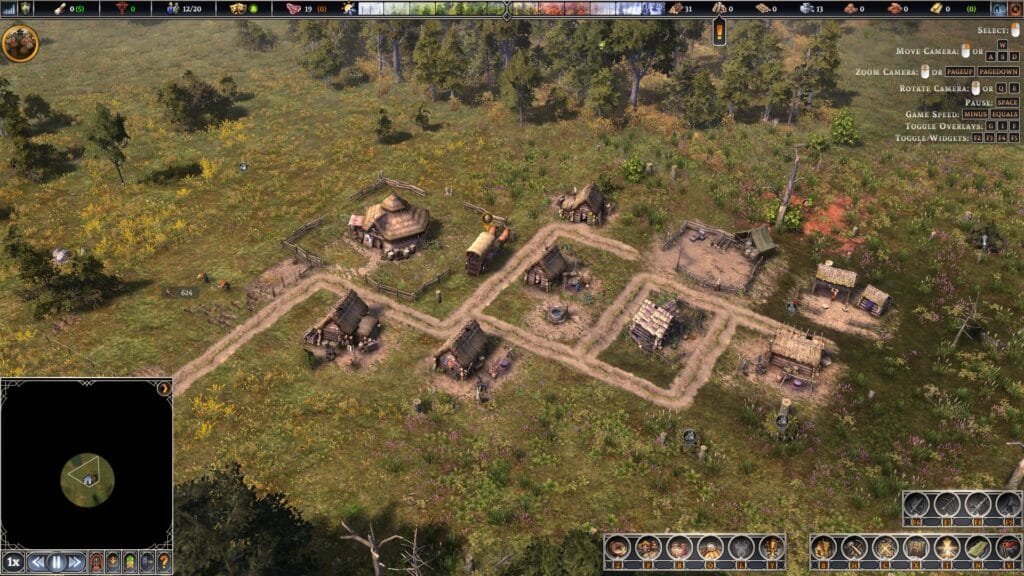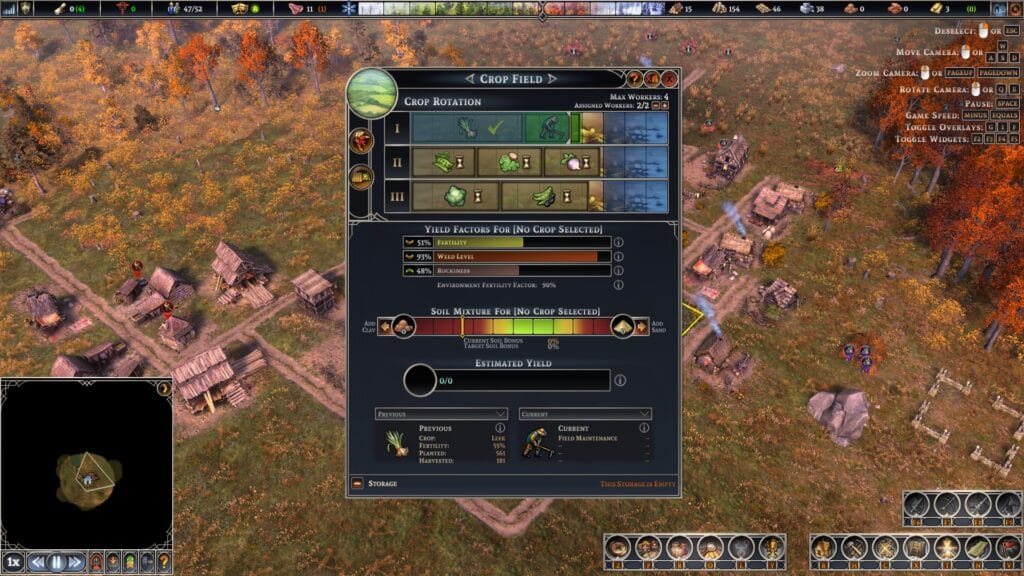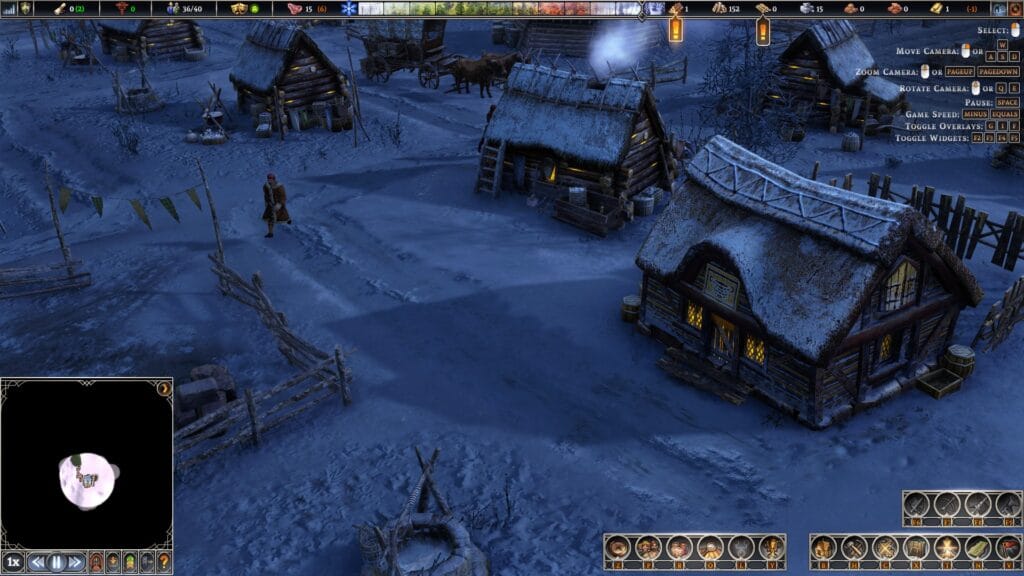There have been many city-building games over the years; obviously the venerable Sim City was one of the first to popularize the genre, but it has expanded into a much wider space today, with simulation city games on the one side, such as Cities: Skylines and Cities XL, and on the other more small scale town or castle-building games, like Stronghold or more recently, Frostpunk. Indeed, a relatively new sub-category is the survival city-builder, which was originally popularized by Banished in 2014 and has seen many new iterations, including Frostpunk 2 last year. Farthest Frontier, which was released in Early Access in 2022 and has now reached version 1.0, is a game very much cribbing from Banished, taking the exact same concept even further.
Farthest Frontier is deliberately generic in both location and time period. It’s not based on any particular country, or any particular year. Instead, it is set broadly within the European Middle Ages, from approx 10-15th Century. You are the leader of a group of villagers who leave their homeland in order to create a new settlement and a place to call their own. You don’t directly control the villagers; instead you assign various tasks to complete, which will be automatically distributed amongst the citizenry. Slowly, you’ll expand the settlement, building housing, services, jobs, and ensuring there is adequate food supply, keeping them happy, fed, and satisfied. Indeed in the early game, food is the overriding concern. The seasons are accurately simulated and you’ll need to plan for the winter months, when food is scarce and villagers are often forced to huddle indoors during blizzards.
The game starts rather like Age of Empires: You build your town center, then start to chop down trees, build houses and create some hunters and foragers to gather food. Gradually, the village will grow in scale, necessitating roads between buildings for swifter travelling, as well as introducing additional services; a sawpit to convert logs into wooden planks, a smokehouse to smoke the meat and fish being collected, so that it lasts longer before spoiling. Indeed, ensuring that you have adequate storehouses for your supplies, and that those supplies don’t spoil too quickly is an important consideration (as well as making sure they don’t become overrun with rats). Soon, you’ll be clearing farmland for gathering crops, even going so far as to plan the tri-annual crop-rotation for each field (making sure that you don’t over-harvest the land, and lose the fertility in the process). You need to balance making sure you have a good variety of crops (vegetables, grain, hay) but also having fallow periods where the soil can rejuvenate.
The game I was most strongly reminded of in the early going was Tropico, which has a similar scale, being focussed on a single settlement rather than an entire civilization. Later on it morphs more into the mould of the Anno series, particularly as concerns such as defending your town from marauders, and generating gold to spend on technological advances. There is a tech tree which you’ll gradually unlock as you construct and upgrade buildings, the town center upgrades mimicking upgrading to the next Age within Age of Empires. Each point on the skill tree confers some benefit, be it minor things like constructing planks faster, to more major advancements like unlocking the village healer, who can help if your citizens get sick from a variety of ailments (dysentery, typhoid, you name it), or are injured fighting wild animals or bandits.
The annual cycle of keeping your people fed and cared for, while gradually expanding the reach and size of your town is an addictive one, where you always feel like you’re making gradual progress, even though it can sometimes take a while. More people will immigrate to your town after a while to help swell the populace, and of course elderly people or those killed in battle will need an appropriate cemetery to be buried in. The game does a great job of meaning you don’t have to micromanage all of this if you don’t want to; all village professions are auto-assigned by default, but you can pick and choose if you want to stop basket-weaving temporarily for example. You can set the focus of particular jobs (such as telling hunters where to hunt), as well as upgrade buildings to make them more effective at their particular function.
For many other activities, villagers respond automatically. During one spring in my playthrough, a bolt of lightning struck the smokehouse, which began to burn down. I panicked at first, but was pleased to see all of the villagers running to the fire and throwing buckets of water on the building, successfully saving it. Defending from attackers can be similar if the townsfolk are appropriately armed with weapons, although building defensive structures and hiring a dedicated military are the best methods, as the soldiers are far better equipped than the average farmer. You’ll want to build walls around key areas as well as keep the town gold stored in a vault, because a bandit raid on an unsuspecting town can mean a difficult and expensive rebuild.
Visually the graphics look wonderful with plenty of detail if you zoom the camera in really close, allowing you to look at individual people going about their jobs, the ox wagons lumbering between the fields and storehouses. The way the seasons change entirely dynamically and smoothly is likewise excellent, really imbibing the entire landscape with a sense of life as the leaves on the trees grow orange and brown, before dropping entirely in winter, the ground blanketed in snow. I also really liked the music; an appropriate mixture of charming medieval-esque tunes you can imagine being played by a band of minstrels.
Farthest Frontier is proof that historical accuracy doesn’t have to rely on exact historical re-enactment of particular events, but instead can be achieved by appropriately simulating the same conditions and technological equipment that ordinary Medieval townsfolk had to live with. This feels very much like a microcosm of authentic Medieval life, with the stresses of food, sickness, the cold, and personal safety looming over everyone’s heads. With its surprisingly involving farming system and a very large list of upgrades to work through and advance your village all the way to a full-fledged city, Farthest Frontier emerges from Early Access as one of the best city builders around.








